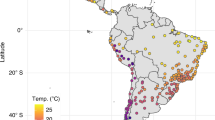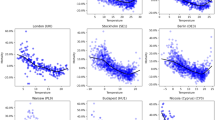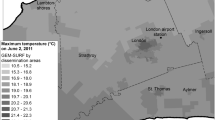Abstract
Rapid build-up of greenhouse gases is expected to increase Earth’s mean surface temperature, with unclear effects on temperature variability1,2,3. This makes understanding the direct effects of a changing climate on human health more urgent. However, the effects of prolonged exposures to variable temperatures, which are important for understanding the public health burden, are unclear. Here we demonstrate that long-term survival was significantly associated with both seasonal mean values and standard deviations of temperature among the Medicare population (aged 65+) in New England, and break that down into long-term contrasts between ZIP codes and annual anomalies. A rise in summer mean temperature of 1 °C was associated with a 1.0% higher death rate, whereas an increase in winter mean temperature corresponded to a 0.6% decrease in mortality. Increases in standard deviations of temperature for both summer and winter were harmful. The increased mortality in warmer summers was entirely due to anomalies, whereas it was long-term average differences in the standard deviation of summer temperatures across ZIP codes that drove the increased risk. For future climate scenarios, seasonal mean temperatures may in part account for the public health burden, but the excess public health risk of climate change may also stem from changes of within-season temperature variability.
This is a preview of subscription content, access via your institution
Access options
Subscribe to this journal
Receive 12 print issues and online access
$209.00 per year
only $17.42 per issue
Buy this article
- Purchase on Springer Link
- Instant access to full article PDF
Prices may be subject to local taxes which are calculated during checkout



Similar content being viewed by others
References
IPCC Climate Change 2013: The Physical Science Basis (eds Stocker, T. et al.) (Cambridge Univ. Press, 2013).
Alexander, L. & Perkins, S. Debate heating up over changes in climate variability. Environ. Res. Lett. 8, 041001 (2013).
Huntingford, C., Jones, P. D., Livina, V. N., Lenton, T. M. & Cox, P. M. No increase in global temperature variability despite changing regional patterns. Nature 500, 327–330 (2013).
Schwartz, J., Samet, J. M. & Patz, J. A. Hospital admissions for heart disease: The effects of temperature and humidity. Epidemiology 15, 755–761 (2004).
Goodman, P. G., Dockery, D. W. & Clancy, L. Cause-specific mortality and the extended effects of particulate pollution and temperature exposure. Environ. Health Perspect. 112, 179–185 (2004).
Barnett, A. G. Temperature and cardiovascular deaths in the US elderly: Changes over time. Epidemiology 18, 369–372 (2007).
Anderson, B. G. & Bell, M. L. Weather-related mortality: How heat, cold, and heat waves affect mortality in the United States. Epidemiology 20, 205–213 (2009).
Yu, W. et al. Daily average temperature and mortality among the elderly: A meta-analysis and systematic review of epidemiological evidence. Int. J. Biometeorol. 56, 569–581 (2012).
Braga, A. L., Zanobetti, A. & Schwartz, J. The effect of weather on respiratory and cardiovascular deaths in 12 US cities. Environ. Health Perspect. 110, 859–863 (2002).
Guo, Y. et al. A large change in temperature between neighbouring days increases the risk of mortality. PLoS ONE 6, e16511 (2011).
Lin, H. et al. Temperature changes between neighboring days and mortality in summer: A distributed lag non-linear time series analysis. PLoS ONE 8, e66403 (2013).
Zanobetti, A., O’Neill, M. S., Gronlund, C. J. & Schwartz, J. D. Summer temperature variability and long-term survival among elderly people with chronic disease. Proc. Natl Acad. Sci. USA 109, 6608–6613 (2012).
Rehill, N., Armstrong, B. & Wilkinson, P. Clarifying life lost due to cold and heat: A new approach using annual time series. BMJ Open 5, e005640 (2015).
Braga, A. L. F., Zanobetti, A. & Schwartz, J. The time course of weather-related deaths. Epidemiology 12, 662–667 (2001).
McGeehin, M. A. & Mirabelli, M. The potential impacts of climate variability and change on temperature-related morbidity and mortality in the United States. Environ. Health Perspect. 109, 185–189 (2001).
Basu, R. High ambient temperature and mortality: A review of epidemiologic studies from 2001 to 2008. Environ. Health 8, 40–52 (2009).
Thomas, D., Stram, D. & Dwyer, J. Exposure measurement error: Influence on exposure-disease relationships and methods of correction. Annu. Rev. Public Health 14, 69–93 (1993).
Kloog, I., Nordio, F., Coull, B. A. & Schwartz, J. Predicting spatiotemporal mean air temperature using MODIS satellite surface temperature measurements across the Northeastern USA. Remote Sens. Environ. 150, 132–139 (2014).
Kloog, I., Melly, S. J., Coull, B. A., Nordio, F. & Schwartz, J. D. Using satellite-based spatiotemporal resolved air temperature exposure to study the association between ambient air temperature and birth outcomes in Massachusetts. Environ. Health Perspect. http://dx.doi.org/10.1289/ehp.1308075 (2015)
Nielsen, B. et al. Human circulatory and thermoregulatory adaptations with heat acclimation and exercise in a hot, dry environment. J. Physiol. 460, 467–485 (1993).
Lippmann, S. J., Fuhrmann, C. M., Waller, A. E. & Richardson, D. B. Ambient temperature and emergency department visits for heat-related illness in North Carolina, 2007–2008. Environ. Res. 124, 35–42 (2013).
Zorita, E. & González-Rouco, F. Disagreement between predictions of the future behavior of the Arctic Oscillation as simulated in two different climate models: Implications for global warming. Geophys. Res. Lett. 27, 1755–1758 (2000).
Riddle, E. E., Butler, A. H., Furtado, J. C., Cohen, J. L. & Kumar, A. CFSv2 ensemble prediction of the wintertime Arctic Oscillation. Clim. Dynam. 41, 1099–1116 (2013).
Petoukhov, V. & Semenov, V. A. A link between reduced Barents–Kara sea ice and cold winter extremes over northern continents. J. Geophys. Res. 115 (2010).
Kloog, I., Coull, B. A., Zanobetti, A., Koutrakis, P. & Schwartz, J. D. Acute and chronic effects of particles on hospital admissions in New-England. PLoS ONE 7, e34664 (2012).
Acknowledgements
This study was funded by NIEHS grants R21ES020695 and R21ES024012. This publication was also made possible by USEPA grant (RD-83479801). Its contents are solely the responsibility of the grantee and do not necessarily represent the official views of the USEPA. Further, USEPA does not endorse the purchase of any commercial products or services mentioned in the publication. The authors also thank L. Shen for fruitful discussions.
Author information
Authors and Affiliations
Contributions
J.D.S. designed the research and directed its implementation; A.Z. and I.K. prepared the data set; L.S., P.L. and J.D.S. analysed data; L.S., P.L. and J.D.S. wrote the paper; all authors contributed to revision of the manuscript.
Corresponding author
Ethics declarations
Competing interests
The authors declare no competing financial interests.
Supplementary information
Rights and permissions
About this article
Cite this article
Shi, L., Kloog, I., Zanobetti, A. et al. Impacts of temperature and its variability on mortality in New England. Nature Clim Change 5, 988–991 (2015). https://doi.org/10.1038/nclimate2704
Received:
Accepted:
Published:
Issue Date:
DOI: https://doi.org/10.1038/nclimate2704
This article is cited by
-
Daily temperature variation in March in East Asia from 1979 to 2020
Climate Dynamics (2024)
-
Temperature variability and common diseases of the elderly in China: a national cross-sectional study
Environmental Health (2023)
-
Decadal trend of synoptic temperature variability over the Northern Hemisphere in winter
Theoretical and Applied Climatology (2023)
-
Analyzing the relationship between air temperature and respiratory morbidity in children and the elderly in Porto Alegre, Brazil, before and during the COVID-19 pandemic
International Journal of Biometeorology (2023)
-
Climate change and cardiovascular disease: implications for global health
Nature Reviews Cardiology (2022)



